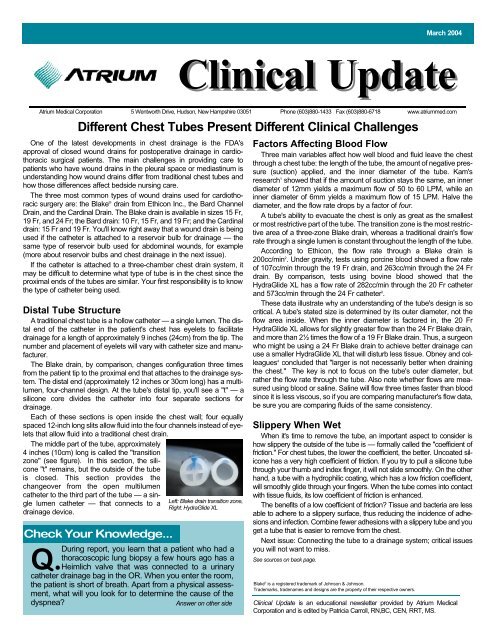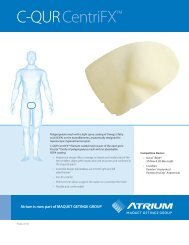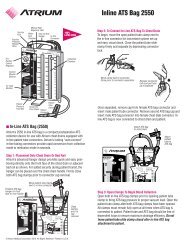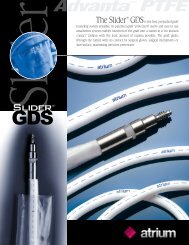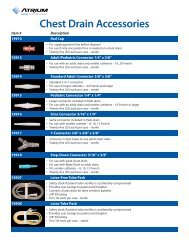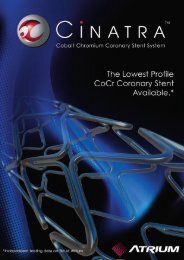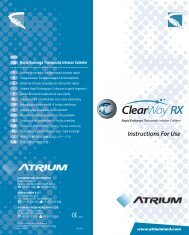Clinical Update - Atrium Medical Corporation
Clinical Update - Atrium Medical Corporation
Clinical Update - Atrium Medical Corporation
- TAGS
- clinical
- atrium
- corporation
Create successful ePaper yourself
Turn your PDF publications into a flip-book with our unique Google optimized e-Paper software.
March 2004<strong>Clinical</strong> <strong>Update</strong><strong>Atrium</strong> <strong>Medical</strong> <strong>Corporation</strong> 5 Wentworth Drive, Hudson, New Hampshire 03051 Phone (603)880-1433 Fax (603)880-6718 www.atriummed.comDifferent Chest Tubes Present Different <strong>Clinical</strong> ChallengesOne of the latest developments in chest drainage is the FDA'sapproval of closed wound drains for postoperative drainage in cardiothoracicsurgical patients. The main challenges in providing care topatients who have wound drains in the pleural space or mediastinum isunderstanding how wound drains differ from traditional chest tubes andhow those differences affect bedside nursing care.The three most common types of wound drains used for cardiothoracicsurgery are: the Blake ® drain from Ethicon Inc., the Bard ChannelDrain, and the Cardinal Drain. The Blake drain is available in sizes 15 Fr,19 Fr, and 24 Fr; the Bard drain: 10 Fr, 15 Fr, and 19 Fr; and the Cardinaldrain: 15 Fr and 19 Fr. You'll know right away that a wound drain is beingused if the catheter is attached to a reservoir bulb for drainage — thesame type of reservoir bulb used for abdominal wounds, for example(more about reservoir bulbs and chest drainage in the next issue).If the catheter is attached to a three-chamber chest drain system, itmay be difficult to determine what type of tube is in the chest since theproximal ends of the tubes are similar. Your first responsibility is to knowthe type of catheter being used.Distal Tube StructureA traditional chest tube is a hollow catheter — a single lumen. The distalend of the catheter in the patient's chest has eyelets to facilitatedrainage for a length of approximately 9 inches (24cm) from the tip. Thenumber and placement of eyelets will vary with catheter size and manufacturer.The Blake drain, by comparison, changes configuration three timesfrom the patient tip to the proximal end that attaches to the drainage system.The distal end (approximately 12 inches or 30cm long) has a multilumen,four-channel design. At the tube's distal tip, you'll see a "t" — asilicone core divides the catheter into four separate sections fordrainage.Each of these sections is open inside the chest wall; four equallyspaced 12-inch long slits allow fluid into the four channels instead of eyeletsthat allow fluid into a traditional chest drain.The middle part of the tube, approximately4 inches (10cm) long is called the "transitionzone" (see figure). In this section, the silicone"t" remains, but the outside of the tubeis closed. This section provides thechangeover from the open multilumencatheter to the third part of the tube — a singlelumen catheter — that connects to adrainage device.Check Your Knowledge...Q.Left: Blake drain transition zone,Right: HydraGlide XLDuring report, you learn that a patient who had athoracoscopic lung biopsy a few hours ago has aHeimlich valve that was connected to a urinarycatheter drainage bag in the OR. When you enter the room,the patient is short of breath. Apart from a physical assessment,what will you look for to determine the cause of thedyspnea?Answer on other sideFactors Affecting Blood FlowThree main variables affect how well blood and fluid leave the chestthrough a chest tube: the length of the tube, the amount of negative pressure(suction) applied, and the inner diameter of the tube. Kam'sresearch 1 showed that if the amount of suction stays the same, an innerdiameter of 12mm yields a maximum flow of 50 to 60 LPM, while aninner diameter of 6mm yields a maximum flow of 15 LPM. Halve thediameter, and the flow rate drops by a factor of four.A tube's ability to evacuate the chest is only as great as the smallestor most restrictive part of the tube. The transition zone is the most restrictivearea of a three-zone Blake drain, whereas a traditional drain's flowrate through a single lumen is constant throughout the length of the tube.According to Ethicon, the flow rate through a Blake drain is200cc/min 2 . Under gravity, tests using porcine blood showed a flow rateof 107cc/min through the 19 Fr drain, and 263cc/min through the 24 Frdrain. By comparison, tests using bovine blood showed that theHydraGlide XL has a flow rate of 282cc/min through the 20 Fr catheterand 573cc/min through the 24 Fr catheter 3 .These data illustrate why an understanding of the tube's design is socritical. A tube's stated size is determined by its outer diameter, not theflow area inside. When the inner diameter is factored in, the 20 FrHydraGlide XL allows for slightly greater flow than the 24 Fr Blake drain,and more than 2½ times the flow of a 19 Fr Blake drain. Thus, a surgeonwho might be using a 24 Fr Blake drain to achieve better drainage canuse a smaller HydraGlide XL that will disturb less tissue. Obney and colleagues4 concluded that "larger is not necessarily better when drainingthe chest." The key is not to focus on the tube's outer diameter, butrather the flow rate through the tube. Also note whether flows are measuredusing blood or saline. Saline will flow three times faster than bloodsince it is less viscous, so if you are comparing manufacturer's flow data,be sure you are comparing fluids of the same consistency.Slippery When WetWhen it's time to remove the tube, an important aspect to consider ishow slippery the outside of the tube is — formally called the "coefficient offriction." For chest tubes, the lower the coefficient, the better. Uncoated siliconehas a very high coefficient of friction. If you try to pull a silicone tubethrough your thumb and index finger, it will not slide smoothly. On the otherhand, a tube with a hydrophilic coating, which has a low friction coefficient,will smoothly glide through your fingers. When the tube comes into contactwith tissue fluids, its low coefficient of friction is enhanced.The benefits of a low coefficient of friction? Tissue and bacteria are lessable to adhere to a slippery surface, thus reducing the incidence of adhesionsand infection. Combine fewer adhesions with a slippery tube and youget a tube that is easier to remove from the chest.Next issue: Connecting the tube to a drainage system; critical issuesyou will not want to miss.See sources on back page.Blake ® is a registered trademark of Johnson & Johnson.Trademarks, tradenames and designs are the property of their respective owners.<strong>Clinical</strong> <strong>Update</strong> is an educational newsletter provided by <strong>Atrium</strong> <strong>Medical</strong><strong>Corporation</strong> and is edited by Patricia Carroll, RN,BC, CEN, RRT, MS.


